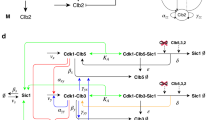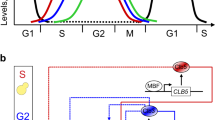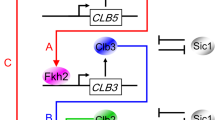Abstract
In yeast and somatic cells, mechanisms ensure cell-cycle events are initiated only when preceding events have been completed1. In contrast, interruption of specific cell-cycle processes in early embryonic cells of many organisms does not affect the timing of subsequent events2, indicating that cell-cycle events are triggered by a free-running cell-cycle oscillator. Here we present evidence for an independent cell-cycle oscillator in the budding yeast Saccharomyces cerevisiae. We observed periodic activation of events normally restricted to the G1 phase of the cell cycle, in cells lacking mitotic cyclin-dependent kinase activities that are essential for cell-cycle progression. As in embryonic cells, G1 events cycled on schedule, in the absence of S phase or mitosis, with a period similar to the cell-cycle time of wild-type cells. Oscillations of similar periodicity were observed in cells responding to mating pheromone in the absence of G1 cyclin (Cln)- and mitotic cyclin (Clb)-associated kinase activity, indicating that the oscillator may function independently of cyclin-dependent kinase dynamics. We also show that Clb-associated kinase activity is essential for ensuring dependencies by preventing the initiation of new G1 events when cell-cycle progression is delayed.
This is a preview of subscription content, access via your institution
Access options
Subscribe to this journal
Receive 51 print issues and online access
$199.00 per year
only $3.90 per issue
Buy this article
- Purchase on Springer Link
- Instant access to full article PDF
Prices may be subject to local taxes which are calculated during checkout



Similar content being viewed by others
References
Hartwell,L. H. & Weinert,T. A. Checkpoints: Controls that ensure the order of cell cycle events. Science 246, 629–634 (1989).
Murray,A. W. & Kirschner,M. W. Dominoes and clocks: the union of two views of the cell cycle. Science 246, 614–621 (1989).
Hartwell,L. H. Genetic control of the cell division cycle in yeast. Exp. Cell Res. 69, 265–276 (1971).
Mathias,N. et al. Cdc53p acts in concert with Cdc4p and Cdc34p to control the G1-to-S-phase transition and identifies a conserved family of proteins. Mol. Cell. Biol. 16, 6634–6643 (1996).
Schwob,E., Bohm,T., Mendenhall,M. D. & Nasmyth,K. The B-type cyclin kinase inhibitor p40SIC1 controls the G1 to S transition in S. cerevisiae. Cell 79, 233–244 (1994).
Reed,S., Wittenberg,C., Lew,D., Dulic,V. & Henze,M. G1 control in yeast and animal cells. Cold Spring Harb. Symp. quant. Biol. 56, 61–67 (1992).
Dirick,L. & Nasmyth,K. Positive feedback in the activation of G1 cyclins in yeast. Nature 351, 754–757 (1991).
Cross,F. R. & Tinkelenberg,A. H. A potential positive feedback loop controlling CLN1 and CLN2 gene expression at the start of the yeast cell cycle. Cell 65, 875–883 (1991).
Tyers,M., Tokiwa,G., Nash,R. & Futcher,B. The Cln3-Cdc28 kinase complex of S. cerevisiae is regulated by proteolysis and phosphorylation. EMBO J. 11, 1773–1784 (1992).
Lanker,S., Valdivieso,M. H. & Wittenberg,C. Rapid degradation of the G1 cyclin Cln2 induced by CDK-dependent phosphorylation. Science 271, 1597–1601 (1996).
Bucking-Throm,E., Duntze,W., Hartwell,L. H. & Manney,T. R. Reversible arrest of haploid yeast cells in the initiation of DNA synthesis by a diffusible sex factor. Exp. Cell Res. 76, 99–100 (1973).
Chenevert,J., Valtz,N. & Herskowitz,I. Identification of genes required for normal pheromone-induced cell polarization in Saccharomyces cerevisiae. Genetics 136, 1287–1296 (1994).
Gehrung,S. & Snyder,M. The SPA2 gene of Saccharomyces cerevisiae is important for pheromone-induced morphogenesis and efficient mating. J. Cell Biol. 111, 1451–1464 (1990).
Surana,U. et al. The role of CDC28 and cyclins during mitosis in the budding yeast S. cerevisiae. Cell 65, 145–161 (1991).
Basco,R. D., Segal,M. D. & Reed,S. I. Negative regulation of G1 and G2 by S-phase cyclins of Saccharomyces cerevisiae. Mol. Cell. Bio. 15, 5030–5042 (1995).
Stueland,C. S., Lew,D. J. & Reed,S. I. Full activation of p34CDC28 histone H1 kinase activity is unable to promote entry into mitosis in checkpoint-arrested cells of the yeast Saccharomyces cerevisiae. Mol. Cell. Biol. 13, 3744–3755 (1993).
Sorger,P. K. & Murray,A. W. S-phase feedback control in budding yeast independent of tyrosine phosphorylation of p34cdc28. Nature 355, 365–368 (1992).
Verma,R. et al. Phosphorylation of Sic1p by G1 Cdk required for its degradation and entry into S phase. Science 278, 455–460 (1997).
Sclafani,R. A. & Fangman,W. L. Yeast gene CDC8 encodes thymidylate kinase and is complemented by the herpes thymidine kinase gene TK. Proc. Natl Acad. Sci. USA 81, 5821–5825 (1984).
Schwab,M., Lutum,A. S. & Seufert,W. Yeast Hct1 is a regulator of Clb2 cyclin proteolysis. Cell 90, 683–693 (1997).
Dahmann,C., Diffley,J. F. & Nasmyth,K. A. S-phase-promoting cyclin-dependent kinases prevent re-replication by inhibiting the transition of replication origins to a pre-replicative state. Curr. Biol. 5, 1257–1269 (1995).
Amon,A., Tyers,M., Futcher,B. & Nasmyth,K. Mechanisms that help the yeast cell cycle clock tick: G2 cyclins transcriptionally activate G2 cyclins and repress G1 cyclins. Cell 74, 993–1007 (1993).
Novak,B. & Mitchison,J. M. Change in the rate of CO2 production in synchronous cultures of the fission yeast Schizosaccharomyces pombe: a periodic cell cycle event that persists after the DNA-division cycle has been blocked. J. Cell. Sci. 86, 191–206 (1986).
Measday,V. et al. A family of cyclin-like proteins that interact with the Pho85 cyclin-dependent kinase. Mol. Cell. Biol. 17, 1212–1223 (1997).
Ngo,L. G. & Roussel,M. R. A new class of biochemical oscillator models based on competitive binding. Eur. J. Biochem. 245, 182–190 (1997).
Whitaker,M. & Patel,R. Calcium and cell cycle control. Development 108, 525–542 (1990).
Collart,M. A. & Oliviero,S. in Current Protocols in Molecular Biology Vol. 2 13.12 (Current Protocols, John Wiley and Sons, New York, 1993).
Xu,H., Kim,U. J., Schuster,T. & Grunstein,M. Identification of a new set of cell cycle-regulatory genes that regulate S-phase transcription of histone genes in Saccharomyces cerevisiae. Mol. Cell. Biol. 12, 5249–5259 (1992).
Adams,A. E. M. & Pringle,J. R. Staining of actin with fluorochrome-conjugated phalloidin. Methods Enzymol. 194, 729–731 (1991).
Spellman,P. T. et al. Comprehensive identification of cell cycle-regulated genes of the yeast Saccharomyces cerevisiae by microarray hybridization. Mol. Biol. Cell 9, 3273–3297 (1998).
Acknowledgements
We thank R. Deshaies for the stabilized Sic1-Δ3P construct; D. Stuart for the triple cln null mutant strain; M. Grunstein for the HTA1/PRT1 probe; C. Wittenberg, N. Rhind and K. Sato for critical review of the manuscript; and members of the Reed laboratory for helpful discussions. This work was supported in part by the Leukemia Society of America and the NIH.
Author information
Authors and Affiliations
Corresponding author
Rights and permissions
About this article
Cite this article
Haase, S., Reed, S. Evidence that a free-running oscillator drives G1 events in the budding yeast cell cycle. Nature 401, 394–397 (1999). https://doi.org/10.1038/43927
Received:
Accepted:
Issue Date:
DOI: https://doi.org/10.1038/43927
This article is cited by
-
Conservation of dynamic characteristics of transcriptional regulatory elements in periodic biological processes
BMC Bioinformatics (2022)
-
Cyclin/Forkhead-mediated coordination of cyclin waves: an autonomous oscillator rationalizing the quantitative model of Cdk control for budding yeast
npj Systems Biology and Applications (2021)
-
Peroxiredoxins couple metabolism and cell division in an ultradian cycle
Nature Chemical Biology (2021)
-
Create, activate, destroy, repeat: Cdk1 controls proliferation by limiting transcription factor activity
Current Genetics (2016)
-
Coupling the cell cycle to cell growth
EMBO reports (2003)
Comments
By submitting a comment you agree to abide by our Terms and Community Guidelines. If you find something abusive or that does not comply with our terms or guidelines please flag it as inappropriate.



